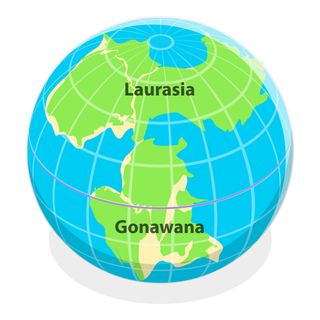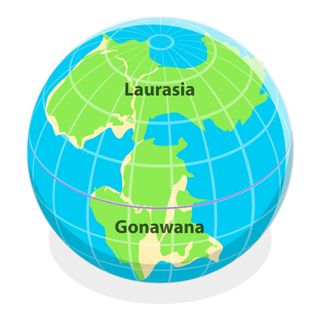Over 400 million years ago, an upwelling of hot rock from Earth’s mantle wrenched apart the crust in Mongolia, creating an ocean that survived for 115 million years.
The geological history of this ocean could help researchers understand Wilson cycles, or the process by which supercontinents break apart and come together. These are slow, broad-scale processes that progress by less than an inch per year, said study co-author Daniel Pastor-Galán, a geoscientist at the National Spanish Research Council in Madrid.
“It’s telling us about processes in the earth that are not very easy to understand and that are also not very easy to see,” Pastor-Galán told Live Science.
Geoscientists can fairly accurately reconstruct the breakup of the last supercontinent, Pangea, 250 million years ago. But prior to that, it’s difficult to model exactly how the mantle and the crust interacted.
In a new study, researchers were intrigued by volcanic rocks in northwestern Mongolia from the Devonian period (419 million to 359 million years ago).
Related: Gravitational anomalies reveal seamount 3 times the height of world’s tallest building
The Devonian was the “Age of the Fishes,” when fish dominated the oceans and plants began to spread on land. At the time, there were two major continents, Laurentia and Gondwana, as well as a long stretch of microcontinents that would eventually become what is now Asia. These microcontinents gradually bumped up against each other and merged in a process called accretion.

The researchers began doing fieldwork in northwest Mongolia where rocks from these continent-building collisions are exposed on the surface, in 2019, studying the ages and chemistry of the ancient rock layers. They found that between about 410 million and 415 million years ago, an ocean called the Mongol-Okhotsk Ocean opened up in the region. The chemistry of the volcanic rocks that accompanied this rift revealed the presence of a mantle plume — a stream of particularly hot, buoyant mantle rock.
“Mantle plumes are usually involved in the first stage of the Wilson cycle: breakup of continents and opening of ocean, such as the Atlantic Ocean,” study lead author Mingshuai Zhu, a professor of geology and geophysics at the Chinese Academy of Sciences, told Live Science.
In many cases, this happens right in the middle of a solid chunk of continent, tearing it apart. In this case, though, the geology is particularly complex, because the plume was tearing apart crust that had previously come together through accretion. Weak spots between the accreted microcontinents, combined with the plume, probably helped the ocean to form, Zhu said. The researchers published their findings May 16 in the journal Geophysical Research Letters.
RELATED STORIES
The ocean closed in the same spot that it opened, which is a common pattern in ocean life-cycles, Pastor-Galán said, but researchers only looked at a snapshot of the ocean’s opening in this study.
“A good thing is that a hotspot is relatively stable so they keep on, for many millions of years, in the same place,” Pastor-Galán said. As continents in the crust move over the mantle hotspot, the hotspot leaves behind volcanic rocks and a tell-tale chemistry; this helps researchers track plate motion over millennia, he said.
Asia is no longer accreting new microcontinents, Pastor-Galán said, but the formation of the Mongol-Okhotsk Ocean was probably similar to what is seen today at the Red Sea, where the crust is spreading by about 0.4 inches (1 centimeter) per year. The Red Sea is part of a larger continental rift that could create a brand-new ocean in eastern Africa over tens of millions of years, though geologists don’t yet know whether other continental forces will prevent that ocean from fully opening, according to Eos magazine.
Zhu and his colleagues now plan to use their data to make computer models to better describe the complicated tectonics of the ancient Devonian ocean.



